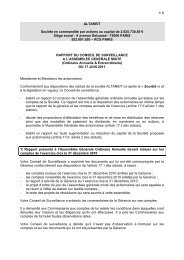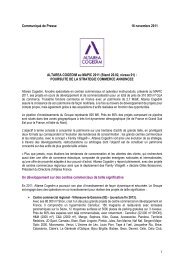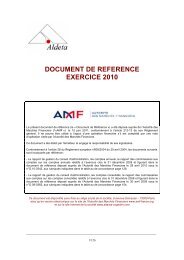Annual report 2008 - Altarea Cogedim
Annual report 2008 - Altarea Cogedim
Annual report 2008 - Altarea Cogedim
You also want an ePaper? Increase the reach of your titles
YUMPU automatically turns print PDFs into web optimized ePapers that Google loves.
• Lessee termination fees<br />
Termination fees are charged to tenants when they terminate<br />
the lease before the end of the contract term.<br />
These fees are accounted for as part of the lease agreement<br />
that was terminated and are taken to income in the year<br />
they are recognised.<br />
• Early termination fees<br />
When the lessor terminates a lease before its term, the<br />
lessor pays a termination fee to the tenant in place.<br />
a) Replacement of a tenant<br />
If payment of an early termination fee enables performance<br />
of the asset to be enhanced (as by increasing the rent<br />
and thereby the value of the asset), this expenditure may<br />
be capitalised. If not, this expenditure is expensed as<br />
incurred.<br />
b) Renovation of a building requiring removal of the tenants<br />
in place<br />
If an early termination fee is paid as part of major renovation<br />
or reconstruction work on a building that requires tenants<br />
to leave, this expenditure is capitalised and included in the<br />
cost of the asset under development.<br />
n Leases in the financial statements with the Group as lessee<br />
Leases of land or buildings and construction leases are<br />
classified either as finance leases or as operating leases on<br />
the same basis as leases of other assets. If the lease does<br />
not provide for transfer of ownership to the lessee at the end<br />
of the lease term, it is presumed to be an operating lease.<br />
An upfront payment on such a lease represents prepaid rent<br />
that is recognised in prepaid expenses and then spread<br />
over the term of the lease. Each lease agreement requires a<br />
specific analysis of its terms.<br />
In 2007, the Group acquired some commercial properties<br />
under finance leases.<br />
7.26. Gain or loss on the disposal of<br />
investment assets<br />
The gain or loss on disposal of investment properties is the<br />
difference between the selling price received net of related<br />
costs and the fair value of the property on the closing<br />
balance sheet for the previous period.<br />
7.27. Change in the fair value of investment<br />
properties<br />
The change in fair value of each property is reflected in<br />
the income statement of the period and is determined as<br />
follows:<br />
Market value at the end of the period (taking into account<br />
the impact of stepped rents and rent holidays as measured<br />
by the property appraiser) minus [Market value at the end<br />
of the previous period + amount of construction work and<br />
expenses eligible for capitalisation during the year]<br />
7.28. Borrowing costs or costs of interestbearing<br />
liabilities<br />
In accordance with the revised IAS 23, borrowing costs<br />
directly attributable to the construction of qualifying assets<br />
are included in the cost of these assets.<br />
Finance costs attributable to programmes are capitalised as<br />
part of the cost of inventories or assets under development<br />
during the construction phase, except in certain cases.<br />
The net cost of debt includes interest incurred on<br />
borrowings and other financial liabilities, income from loans<br />
and advances to participating interests, gains on sale of<br />
marketable securities and the impact of interest-rate swaps<br />
used as interest-rate hedges.<br />
Where there is a significant delay in the construction project,<br />
management may decide if the delay is unusually long not<br />
to capitalise finance costs attributable to the programme<br />
any longer. Management estimates the date at which the<br />
capitalisation of finance costs may resume.<br />
7.29. Discounting of payables and<br />
receivables<br />
This line item shows the combined effect of discounting<br />
payables and receivables due in more than one year to present<br />
value. This effect is recognised under the “Discounting of<br />
payables and receivables” line item.<br />
97

















